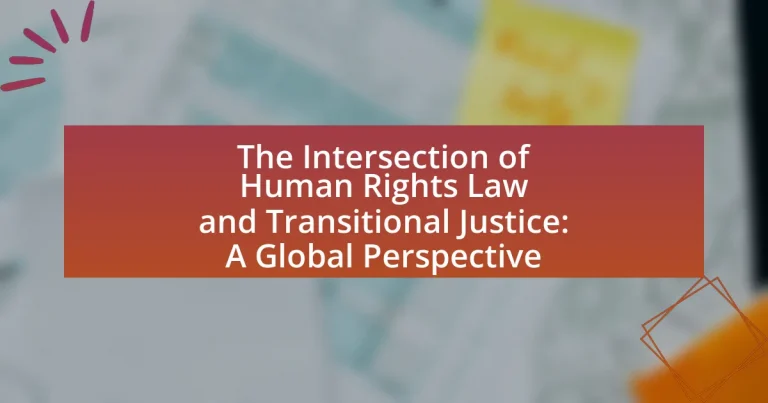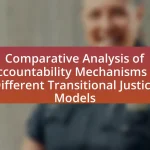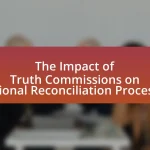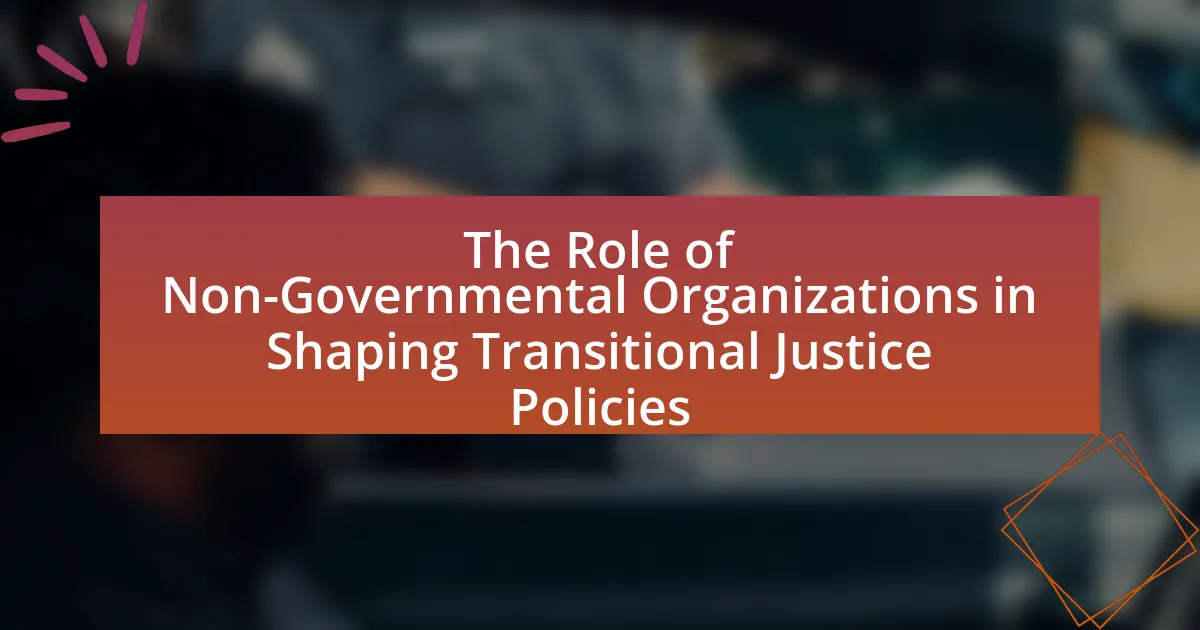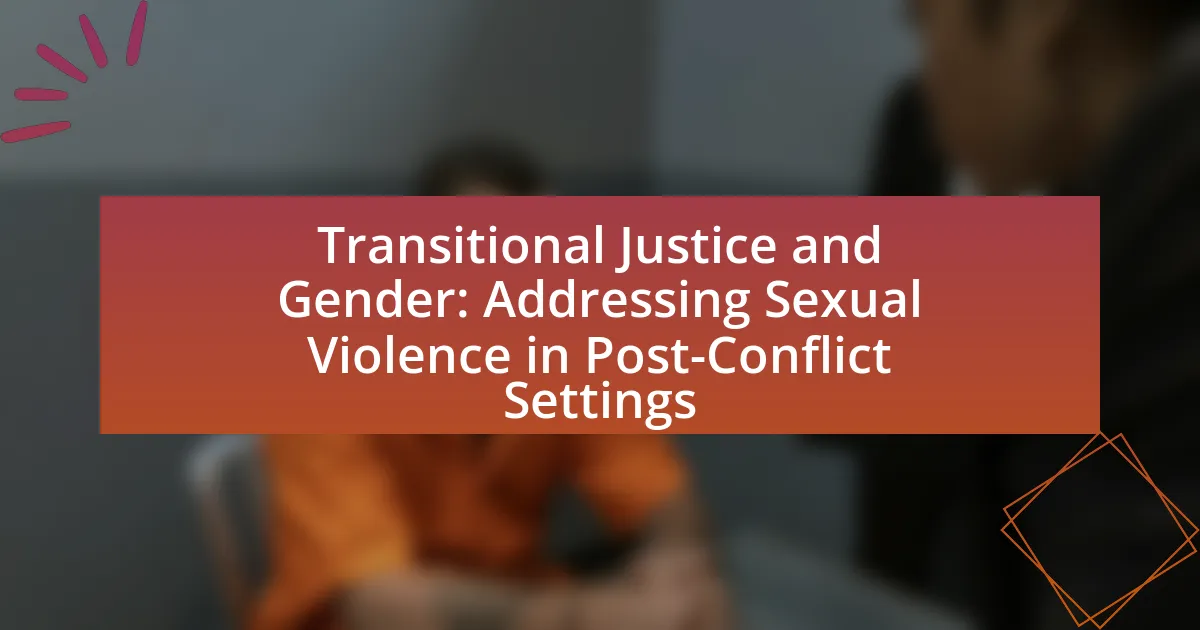The article examines the intersection of human rights law and transitional justice, emphasizing their shared objective of addressing past human rights violations and fostering accountability in post-conflict societies. It outlines the fundamental principles of human rights law, such as universality and inalienability, and key components of transitional justice, including truth-seeking and reparations. The discussion highlights global perspectives, regional approaches, and the unique challenges faced in implementing these frameworks, particularly in Africa. Additionally, it explores the role of international law, civil society, and education in promoting awareness and effective integration of human rights law and transitional justice mechanisms.
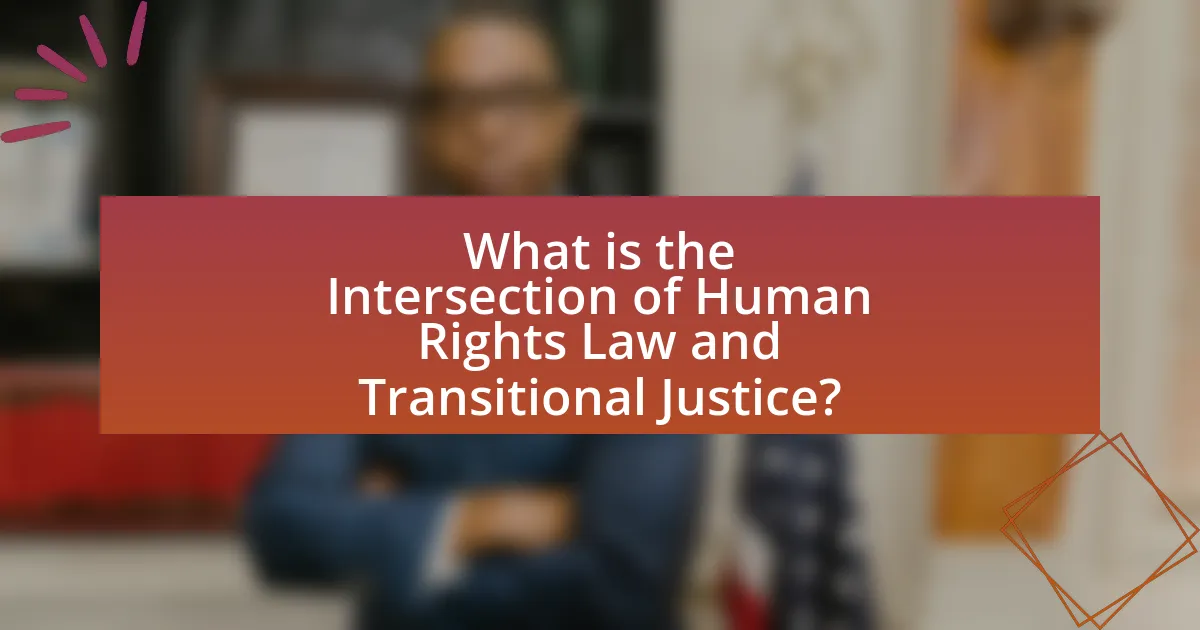
What is the Intersection of Human Rights Law and Transitional Justice?
The intersection of human rights law and transitional justice lies in their shared goal of addressing past human rights violations and promoting accountability, justice, and reconciliation in post-conflict societies. Human rights law provides the legal framework that obligates states to protect individuals from abuses, while transitional justice mechanisms, such as truth commissions and reparations, seek to address the legacies of conflict and authoritarian rule by ensuring victims’ rights are recognized and upheld. For instance, the establishment of the International Criminal Court (ICC) exemplifies how human rights law informs transitional justice by holding perpetrators accountable for crimes against humanity, thereby reinforcing the principles of justice and rule of law in transitional contexts.
How do Human Rights Law and Transitional Justice relate to each other?
Human Rights Law and Transitional Justice are interconnected as both aim to address and rectify past human rights violations, ensuring accountability and promoting justice in post-conflict societies. Human Rights Law provides the legal framework that defines rights and protections for individuals, while Transitional Justice encompasses the mechanisms and processes, such as truth commissions and reparations, that seek to address the legacies of mass atrocities. For instance, the establishment of the International Criminal Court is a direct application of Human Rights Law that supports Transitional Justice by prosecuting individuals for war crimes and crimes against humanity, thereby reinforcing the rule of law and promoting societal healing.
What are the fundamental principles of Human Rights Law?
The fundamental principles of Human Rights Law include universality, inalienability, indivisibility, and equality. Universality asserts that human rights apply to all individuals regardless of nationality, ethnicity, or any other status, as established in the Universal Declaration of Human Rights (UDHR) adopted by the United Nations in 1948. Inalienability means that human rights cannot be taken away or transferred, emphasizing that they are inherent to all human beings. Indivisibility highlights that all rights, whether civil, political, economic, social, or cultural, are equally important and interdependent. Lastly, equality ensures that all individuals are entitled to their rights without discrimination, a principle reinforced by various international treaties, including the International Covenant on Civil and Political Rights. These principles form the foundation of Human Rights Law and guide its application globally.
What are the key components of Transitional Justice?
The key components of Transitional Justice include truth-seeking, accountability, reparations, and institutional reform. Truth-seeking mechanisms, such as truth commissions, aim to uncover the facts about past human rights violations, fostering public acknowledgment. Accountability is pursued through legal processes to hold perpetrators responsible, often involving trials or other judicial measures. Reparations provide compensation and recognition to victims, addressing the harm suffered. Institutional reform focuses on restructuring state institutions to prevent future abuses, ensuring adherence to human rights standards. These components collectively aim to promote healing, restore dignity, and establish the rule of law in post-conflict societies.
Why is the intersection of these fields significant globally?
The intersection of human rights law and transitional justice is significant globally because it provides a framework for addressing past atrocities while promoting accountability and reconciliation. This intersection facilitates the establishment of legal standards that protect individual rights and ensure that victims of human rights violations receive justice. For instance, the International Criminal Court (ICC) has been instrumental in prosecuting war crimes and crimes against humanity, reinforcing the importance of legal accountability in transitional contexts. Furthermore, countries transitioning from conflict or authoritarian rule, such as South Africa post-apartheid, have utilized truth commissions to uncover abuses and foster societal healing, demonstrating the practical application of these fields in promoting peace and stability.
How does this intersection impact victims of human rights violations?
The intersection of human rights law and transitional justice significantly impacts victims of human rights violations by providing mechanisms for accountability and redress. This intersection facilitates the establishment of legal frameworks that hold perpetrators accountable, thereby offering victims a sense of justice and recognition. For instance, the establishment of truth commissions and international tribunals, such as the International Criminal Court, has been pivotal in addressing past atrocities and ensuring that victims’ voices are heard. According to the United Nations, transitional justice processes can lead to improved societal healing and reconciliation, which are essential for victims to rebuild their lives after experiencing violations.
What role does international law play in this intersection?
International law serves as a framework that guides the integration of human rights law and transitional justice, ensuring accountability for human rights violations during periods of political transition. It establishes legal standards and obligations for states to protect human rights, promote justice, and provide remedies for victims, as seen in instruments like the International Covenant on Civil and Political Rights and the Rome Statute of the International Criminal Court. These legal frameworks compel nations to address past atrocities, thereby fostering reconciliation and preventing future violations.
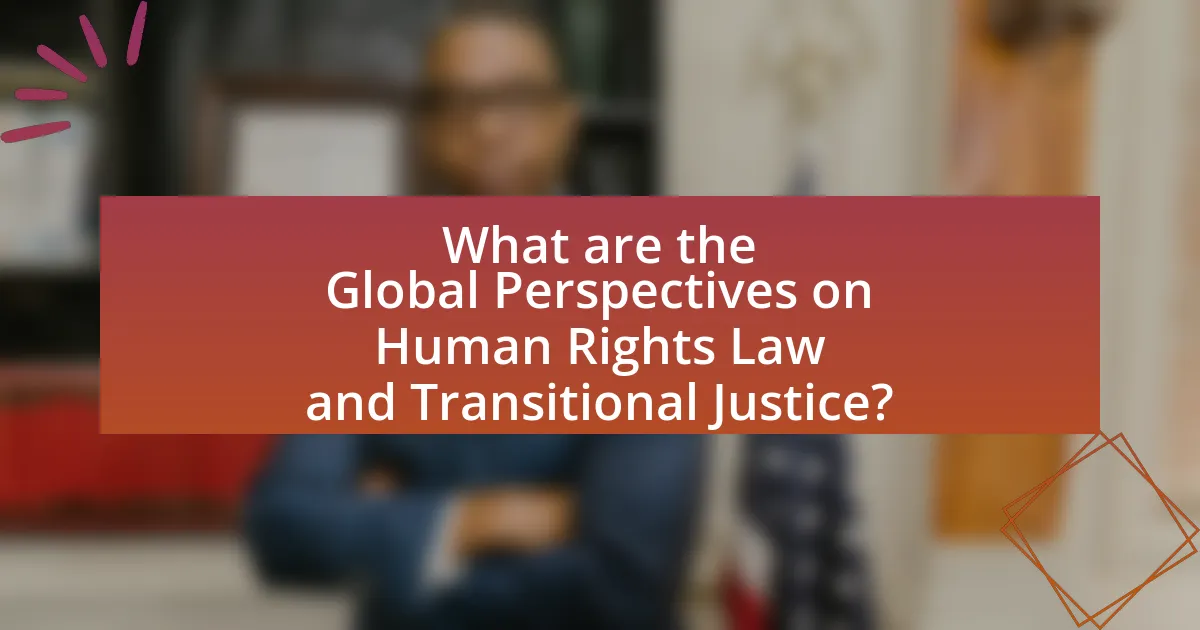
What are the Global Perspectives on Human Rights Law and Transitional Justice?
Global perspectives on human rights law and transitional justice emphasize the need for accountability, truth, and reconciliation in post-conflict societies. Various countries adopt different approaches based on their historical contexts; for instance, South Africa’s Truth and Reconciliation Commission is often cited as a model for balancing justice and societal healing after apartheid. In contrast, countries like Rwanda have implemented gacaca courts to address genocide-related crimes, focusing on community involvement and restorative justice. These diverse methodologies reflect the global recognition that transitional justice must be tailored to specific cultural and political landscapes, ensuring that human rights law serves as a foundation for rebuilding societies and preventing future atrocities.
How do different regions approach the intersection of these fields?
Different regions approach the intersection of human rights law and transitional justice through varied frameworks and practices shaped by their historical, cultural, and political contexts. For instance, Latin America often emphasizes truth commissions and reparations, as seen in countries like Argentina and Chile, where these mechanisms have been pivotal in addressing past human rights violations. In contrast, Africa frequently utilizes a combination of traditional justice mechanisms and formal legal processes, exemplified by South Africa’s Truth and Reconciliation Commission, which aimed to foster national unity post-apartheid. Meanwhile, Europe tends to focus on legal accountability through international courts, such as the International Criminal Court, to address war crimes and crimes against humanity. These regional approaches reflect the unique challenges and priorities each area faces in reconciling past injustices with contemporary human rights standards.
What are the unique challenges faced in Africa regarding this intersection?
Africa faces unique challenges at the intersection of human rights law and transitional justice, primarily due to political instability, weak legal frameworks, and socio-economic disparities. Political instability often leads to a lack of accountability for human rights violations, as seen in countries like Sudan and the Democratic Republic of the Congo, where ongoing conflicts hinder the implementation of justice mechanisms. Weak legal frameworks further complicate the enforcement of human rights laws, as many African nations struggle with inadequate judicial systems that lack the capacity to address transitional justice effectively. Additionally, socio-economic disparities create barriers to accessing justice, as marginalized communities often lack the resources to engage with legal processes. These factors collectively impede the realization of human rights and the establishment of effective transitional justice in the region.
How does the approach differ in Europe compared to Latin America?
The approach to transitional justice in Europe differs from that in Latin America primarily in the emphasis on legal accountability versus restorative justice. In Europe, transitional justice often focuses on legal mechanisms, such as trials and prosecutions, to address past human rights violations, exemplified by the Nuremberg Trials and the International Criminal Court’s role in prosecuting war crimes. In contrast, Latin America tends to prioritize truth commissions and reparations, as seen in countries like Argentina and Chile, where the emphasis is on acknowledging victims’ experiences and fostering societal reconciliation rather than solely punishing perpetrators. This divergence reflects varying historical contexts and societal needs, with Europe leaning towards punitive measures and Latin America favoring restorative approaches to heal from past atrocities.
What lessons can be learned from global case studies?
Global case studies reveal that effective transitional justice mechanisms are essential for addressing human rights violations and fostering societal healing. For instance, the Truth and Reconciliation Commission in South Africa demonstrated that public acknowledgment of past atrocities can promote national unity and prevent future conflicts. Additionally, the case of Rwanda’s Gacaca courts illustrates that community-based justice can facilitate reconciliation and empower local populations to address grievances. These examples underscore the importance of tailored approaches that consider cultural contexts and the need for inclusive participation in transitional justice processes.
What successful models exist for integrating Human Rights Law and Transitional Justice?
Successful models for integrating Human Rights Law and Transitional Justice include the South African Truth and Reconciliation Commission (TRC) and the Colombian Peace Agreement. The South African TRC, established in 1995, aimed to address past human rights violations during apartheid by promoting truth-telling and reconciliation, which helped to foster national unity and healing. The commission’s work led to the acknowledgment of victims’ suffering and the establishment of a historical record, which is essential for justice and accountability.
Similarly, the Colombian Peace Agreement, signed in 2016, incorporates human rights law into its transitional justice framework by establishing a Special Jurisdiction for Peace (JEP). This mechanism is designed to investigate and prosecute serious human rights violations committed during the armed conflict, ensuring that victims’ rights are prioritized and that perpetrators are held accountable. Both models demonstrate the effectiveness of integrating human rights law into transitional justice processes to promote accountability, reconciliation, and the rule of law.
How have failures in these areas shaped current practices?
Failures in human rights law and transitional justice have significantly influenced current practices by highlighting the need for more robust accountability mechanisms. For instance, the lack of effective prosecution for war crimes in the aftermath of conflicts has led to the establishment of international tribunals, such as the International Criminal Court, which aims to ensure that perpetrators are held accountable. Additionally, failures in addressing victims’ rights have prompted the integration of victim-centered approaches in transitional justice processes, emphasizing reparations and truth-telling initiatives. These adaptations reflect a growing recognition that without addressing past injustices, sustainable peace and reconciliation remain elusive.
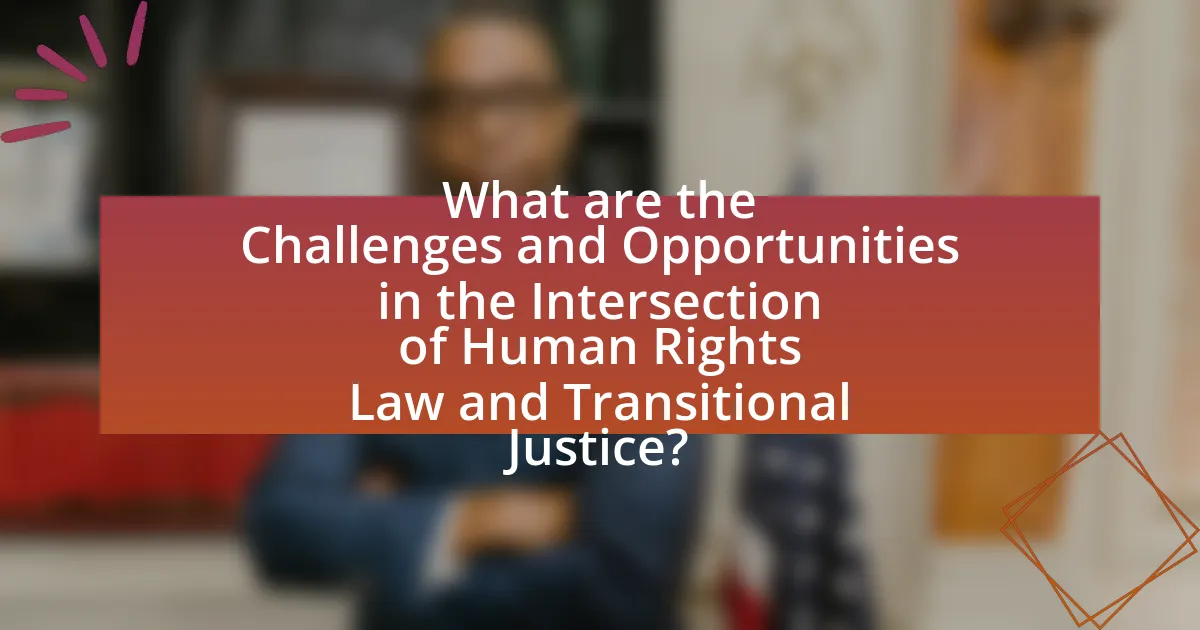
What are the Challenges and Opportunities in the Intersection of Human Rights Law and Transitional Justice?
The challenges in the intersection of human rights law and transitional justice include the difficulty of reconciling legal frameworks with local cultural practices, the potential for political interference in judicial processes, and the risk of insufficient resources to implement justice mechanisms effectively. For instance, in many post-conflict societies, traditional justice systems may conflict with international human rights standards, leading to tensions in achieving accountability.
Opportunities arise from the potential for transitional justice mechanisms to promote accountability, truth-telling, and reconciliation, which can strengthen the rule of law and enhance respect for human rights. Successful examples, such as the Truth and Reconciliation Commission in South Africa, demonstrate how integrating human rights law into transitional justice can foster societal healing and prevent future violations. These mechanisms can also empower victims by giving them a voice and facilitating their participation in the justice process, thereby reinforcing the principles of human rights.
What obstacles hinder effective implementation of these principles?
Obstacles that hinder effective implementation of human rights law and transitional justice principles include lack of political will, inadequate resources, and societal resistance. Political will is often absent in governments that may be implicated in human rights violations, leading to insufficient enforcement of laws and policies. Inadequate resources, both financial and human, limit the capacity of institutions to carry out necessary reforms and provide justice. Societal resistance can arise from entrenched power structures and cultural attitudes that oppose accountability measures, making it difficult to achieve consensus on transitional justice initiatives. These factors collectively impede the realization of justice and accountability in post-conflict settings.
How do political factors influence the application of Human Rights Law?
Political factors significantly influence the application of Human Rights Law by shaping the legal frameworks, enforcement mechanisms, and overall commitment of states to uphold these rights. For instance, governments may prioritize national security or political stability over human rights, leading to selective enforcement or outright violations of laws designed to protect individuals. Historical examples include authoritarian regimes that suppress dissent and manipulate legal systems to justify human rights abuses, as seen in countries like Syria and North Korea, where political agendas directly undermine international human rights obligations. Additionally, political will is crucial; states with strong democratic institutions and civil society engagement are more likely to adhere to human rights standards, as evidenced by the European Union’s emphasis on human rights in its accession criteria for member states.
What are the limitations of Transitional Justice mechanisms?
Transitional Justice mechanisms face several limitations, including their often limited scope, lack of enforcement power, and potential for political manipulation. These mechanisms may not address all forms of injustice, focusing primarily on specific crimes while neglecting broader systemic issues. For instance, truth commissions may reveal past atrocities but lack the authority to enforce reparations or hold perpetrators accountable, as seen in the case of South Africa’s Truth and Reconciliation Commission, which struggled to implement its recommendations. Additionally, political contexts can influence the effectiveness of these mechanisms, leading to selective justice that undermines their legitimacy, as observed in various post-conflict societies where transitional justice processes are co-opted by prevailing political interests.
What opportunities exist for enhancing this intersection?
Opportunities for enhancing the intersection of human rights law and transitional justice include the integration of victim-centered approaches, the strengthening of legal frameworks, and the promotion of international cooperation. Victim-centered approaches ensure that the needs and rights of victims are prioritized, which can lead to more effective and meaningful transitional justice processes. Strengthening legal frameworks involves aligning national laws with international human rights standards, thereby providing a more robust basis for accountability and redress. Additionally, promoting international cooperation can facilitate the sharing of best practices and resources among countries undergoing transitions, enhancing the overall effectiveness of transitional justice mechanisms. These opportunities are supported by various studies indicating that inclusive and legally sound frameworks lead to more sustainable peace and justice outcomes.
How can civil society contribute to strengthening Human Rights Law and Transitional Justice?
Civil society can contribute to strengthening Human Rights Law and Transitional Justice by advocating for accountability, promoting awareness, and facilitating dialogue among stakeholders. Civil society organizations often serve as watchdogs, documenting human rights abuses and pushing for legal reforms that align with international human rights standards. For instance, organizations like Human Rights Watch and Amnesty International have played crucial roles in highlighting violations and influencing policy changes globally. Additionally, civil society can mobilize communities to participate in transitional justice processes, ensuring that victims’ voices are heard and considered in legal frameworks. This engagement fosters a culture of accountability and reconciliation, essential for sustainable peace and justice.
What role does education play in promoting awareness and understanding?
Education plays a crucial role in promoting awareness and understanding by equipping individuals with knowledge about human rights and transitional justice. Through structured curricula, education fosters critical thinking and encourages discussions on historical injustices, legal frameworks, and the importance of accountability. For instance, studies show that educational programs focused on human rights can lead to increased civic engagement and advocacy, as evidenced by the rise in youth-led movements advocating for social justice. Furthermore, educational initiatives that incorporate case studies of transitional justice, such as the Truth and Reconciliation Commission in South Africa, provide concrete examples that enhance comprehension and empathy towards affected communities. This comprehensive approach not only informs individuals but also empowers them to participate actively in societal change.
What best practices can be adopted for effective integration of Human Rights Law and Transitional Justice?
Effective integration of Human Rights Law and Transitional Justice can be achieved through several best practices, including the establishment of inclusive legal frameworks, the promotion of victim participation, and the commitment to accountability mechanisms. Inclusive legal frameworks ensure that both human rights standards and transitional justice principles are embedded in national legislation, which facilitates coherence in addressing past abuses. Promoting victim participation allows affected communities to have a voice in the transitional justice process, ensuring that their needs and perspectives shape the outcomes. Commitment to accountability mechanisms, such as truth commissions and judicial processes, reinforces the rule of law and deters future violations by holding perpetrators accountable. These practices have been observed in various contexts, such as South Africa’s Truth and Reconciliation Commission, which integrated human rights principles into its mandate, demonstrating the effectiveness of these approaches in fostering justice and reconciliation.
